Surat
Surat is a city in the Indian state of Gujarat. It used to be a large seaport and is now the commercial and economic center in South Gujarat, which is famous for its diamonds and textile Industries and as a shopping centre for apparels and accessories . It is the eighth largest city and ninth largest urban agglomeration in India. It is the administrative capital of the Surat district. The city is located 284 kilometres (176 mi) south of the state capital, Gandhinagar; 265 kilometres (165 mi) south of Ahmedabad; and 289 kilometres (180 mi) north of Mumbai. The city centre is located on the Tapti River, close to Arabian Sea.[10]
Surat Suryapur | |
|---|---|
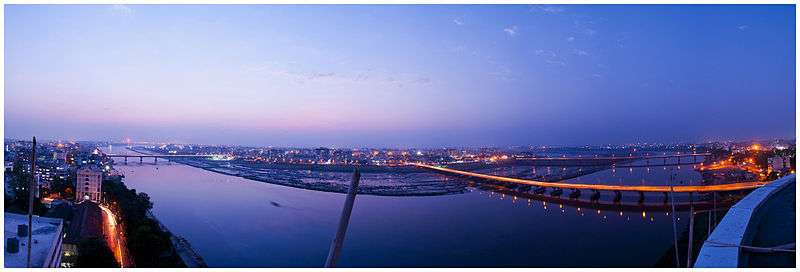 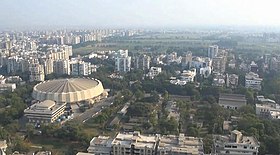  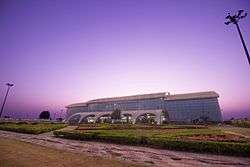 From top: Tapi River paramoma, International Business Center, BAPS Temple Surat, Surat Airport, Surat at night | |
| Nickname(s): Diamond City of India[1] | |
 Surat Location of Surat in Gujarat, India  Surat Surat (India) | |
| Coordinates: 21°10′12.864″N 72°49′51.819″E | |
| Country | |
| State | Gujarat |
| District | Surat |
| Zone | 7 |
| Government | |
| • Type | Mayor–Council |
| • Body | |
| • Mayor | Dr. Jagdish Patel (BJP)[2] |
| • Municipal Commissioner | Shri Banchhanidhi Pani, IAS |
| • Police Commissioner | R B Bhramdatt[3] |
| Area | |
| • Metropolis | 326.515 km2 (126.068 sq mi) |
| • Metro | 326.600 km2 (126.101 sq mi) |
| Elevation | 13 m (43 ft) |
| Population (2011)[5] | |
| • Metropolis | 4,467,797 |
| • Rank | 8th(in India) 2nd (in Gujarat state) |
| • Density | 14,000/km2 (35,000/sq mi) |
| • Metro | 5,935,000[6] |
| • Metro rank | 9th |
| • Demonym | Surti |
| Time zone | UTC+5:30 (IST) |
| Pincode(s) | 394 XXX, 395 XXX |
| Area code(s) | 91-261-XXX-XXXX |
| Vehicle registration | GJ-05, GJ-19, GJ-28[7] |
| Sex ratio | 1.27[8] ♂/♀ |
| Coastline | 35 kilometres (22 mi) |
| Literacy rate | 86.65%[9] |
| Language | Gujarati |
| Website | www |
Surat will be the world's fastest growing city from 2019 to 2035, according to a study conducted by Economic Times.[11] The city registered an annualised GDP growth rate of 11.5% over the seven fiscal years between 2001 and 2008.[12] Surat was awarded "best city" by the Annual Survey of India's City-Systems (ASICS) in 2013.[13] Surat is selected as the first smart IT city in India which is being constituted by the Microsoft CityNext Initiative tied up with IT services majors Tata Consultancy Services and Wipro.[14] The city has 2.97 million internet users, about 65% of total population.[15] Surat was selected in 2015 for an IBM Smarter Cities Challenge grant.[16][17] Surat has been selected as one of twenty Indian cities to be developed as a smart city under PM Narendra Modi's flagship Smart Cities Mission.[18] In 2017, Surat was the fourth cleanest city of India according to the Indian Ministry of Urban Development.[19]
Surat, famous for its diamond cutting and polishing, is known as the Diamond City of India.[1]
Etymology
Surat was founded by a man called Gopi, who named the area Surajpur or Suryapur.[20] Duarte Barbosa described Surat as Suratt. Jacob Peeters referred to Surat as Sourratte which is a Dutch name [21] there are many other names of surat in history. Surat is referred to as Surate or Soorat in some literature.[22]
People from Surat
A resident of Surat is called Surati.
History
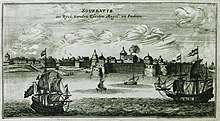
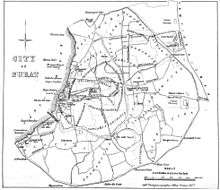
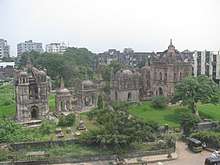
In the 12th and 15th centuries, Surat was managed by Muslims.[20] In 1514, the Portuguese traveler Duarte Barbosa described Surat as an important seaport, frequented by many ships from Malabar and various parts of the world. By 1520, the name of the city had become Surat. It was burned by the Portuguese (1512 and 1530) and conquered by the Mughals (1573) and was twice raided by the Maratha king Shivaji (17th century). [20]
It was the most prosperous port in the Mughal empire.[23] Despite being a rich city, Surat looked like a typical "grubby" trader's town with mud-and-bamboo tenements and crooked streets, although along the riverfront there were a few mansions and warehouses belonging to local merchant princes and the establishments of Turkish, Armenian, English, French and Dutch traders. There were also hospitals for cows, horses, flies and insects run by religious Jains, which puzzled travelers.[23] Some streets were narrow while others were of sufficient width. In the evening, especially near the Bazaar (marketplace), the streets became crowded with people and merchants (including Banyan merchants) selling their goods. Surat was a populous city during the Mughal era but also had a large transient population: during the monsoon season, when ships could come and go from the ports without danger, the city's population would swell.[23] In 1612, England established its first Indian trading factory in Surat.[20] The city was sacked twice by the Maratha king Shivaji, with the first sacking occurring in 1664.[20][10] Shivaji's raids scared trade away and caused ruin to the city.[23]
Later, Surat became the emporium of India, exporting gold and cloth. Its major industries were shipbuilding and textile manufacture.[20] The coast of the Tapti River, from Athwalines to Dumas, was specially meant for shipbuilders, who were usually Rassis.[10] The city continued to be prosperous until the rise of Bombay (present-day Mumbai). Afterwards, Surat's shipbuilding industry declined and Surat itself gradually declined throughout the 18th century.[20][10] Between 1790–1, an epidemic killed 100,000 Gujaratis in Surat.[24] The British and Dutch both claimed control of the city, but in 1800, the British took control of Surat.[20][10]
By the middle of the 19th century, Surat had become a stagnant city with about 80,000 inhabitants. When India's railways opened, the city started becoming prosperous again. Silks, cotton, brocades, and objects of gold and silver from Surat became famous and the ancient art of manufacturing fine muslin was revived.[20]
Geography
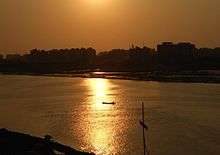
Surat is a port city situated on the banks of the Tapi river. Damming of the Tapi caused the original port facilities to close; the nearest port is now in the Magadalla and Hazira area of Surat Metropolitan Region. It has a famous beach called 'Dumas Beach' located in Hazira. The city is located at 21°10′N 72°50′E.[25] It has an average elevation of 13 metres. The Surat district is surrounded by the Bharuch, Narmada, Navsari, to the west is the Gulf of Cambay and the surrounding districts. The climate is tropical and monsoon rainfall is abundant (about 2,500 mm a year). According to the Bureau of Indian Standards, the town falls under seismic zone-III, in a scale of I to V (in order of increasing vulnerability to earthquakes).[26]
Climate
Surat has a tropical savanna climate (Köppen: Aw), moderated strongly by the Sea to the Gulf of Cambay. The summer begins in early March and lasts until June. April and May are the hottest months, the average maximum temperature being 37 °C (99 °F). Monsoon begins in late June and the city receives about 1,200 millimetres (47 in) of rain by the end of September, with the average maximum being 32 °C (90 °F) during those months. October and November see the retreat of the monsoon and a return of high temperatures until late November. Winter starts in December and ends in late February, with average mean temperatures of around 23 °C (73 °F), and negligible rain.
Since the 20th century, Surat has experienced some 20 floods.[27] In 1968, most parts of the city were flooded and in 1994 a flood caused a country-wide plague outbreak, Surat being the epicenter. In 1998, 30 per cent of Surat had gone under water due to flooding in Tapti river following release of water from Ukai dam located 90 km from Surat and in Aug 2006 flood more than 95 per cent of the city was under Tapti river waters, killing more than 120 people, stranding tens of thousands in their homes without food or electricity and closing businesses and schools for weeks.[28][27]
| Climate data for Surat, Gujarat (1981–2010, extremes 1877–2012) | |||||||||||||
|---|---|---|---|---|---|---|---|---|---|---|---|---|---|
| Month | Jan | Feb | Mar | Apr | May | Jun | Jul | Aug | Sep | Oct | Nov | Dec | Year |
| Record high °C (°F) | 38.3 (100.9) |
41.7 (107.1) |
44.0 (111.2) |
45.6 (114.1) |
45.6 (114.1) |
45.6 (114.1) |
38.9 (102.0) |
37.2 (99.0) |
41.1 (106.0) |
41.4 (106.5) |
39.4 (102.9) |
38.9 (102.0) |
45.6 (114.1) |
| Average high °C (°F) | 30.8 (87.4) |
32.3 (90.1) |
35.4 (95.7) |
36.7 (98.1) |
35.8 (96.4) |
34.0 (93.2) |
31.2 (88.2) |
30.8 (87.4) |
32.3 (90.1) |
35.1 (95.2) |
34.1 (93.4) |
31.9 (89.4) |
33.4 (92.1) |
| Average low °C (°F) | 15.2 (59.4) |
16.7 (62.1) |
20.7 (69.3) |
24.0 (75.2) |
26.8 (80.2) |
27.0 (80.6) |
25.9 (78.6) |
25.5 (77.9) |
25.4 (77.7) |
23.3 (73.9) |
19.6 (67.3) |
16.5 (61.7) |
22.2 (72.0) |
| Record low °C (°F) | 4.4 (39.9) |
5.6 (42.1) |
8.9 (48.0) |
15.0 (59.0) |
19.4 (66.9) |
20.2 (68.4) |
19.9 (67.8) |
21.0 (69.8) |
20.6 (69.1) |
14.4 (57.9) |
10.6 (51.1) |
6.7 (44.1) |
4.4 (39.9) |
| Average rainfall mm (inches) | 1.5 (0.06) |
0.3 (0.01) |
0.4 (0.02) |
0.2 (0.01) |
3.9 (0.15) |
245.2 (9.65) |
466.3 (18.36) |
283.8 (11.17) |
151.8 (5.98) |
41.8 (1.65) |
7.1 (0.28) |
0.6 (0.02) |
1,202.8 (47.35) |
| Average rainy days | 0.1 | 0.1 | 0.0 | 0.0 | 0.3 | 7.0 | 14.6 | 12.7 | 6.7 | 1.7 | 0.5 | 0.0 | 43.8 |
| Average relative humidity (%) (at 17:30 IST) | 41 | 34 | 33 | 42 | 58 | 70 | 80 | 79 | 70 | 52 | 44 | 43 | 53 |
| Source: India Meteorological Department[29][30][31] | |||||||||||||
Economy


Surat ranked 10th in India with a GDP of 2.60 lakh crore in fiscal year 2016 ($37 billion in 2016). Surat GDP in 2020 will be around $57 billion estimated by The City Mayors Foundation, an international think tank on urban affairs. [32]
Diamond polishing
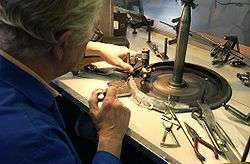
Surat is a major hub of diamond cutting and polishing.[33] The first diamond workshops in Gujarat appeared in Surat and Navasari in the late 1950s. The major group working in this industry is people from the Saurashtra region of Gujarat. Because of demand in the American market from the early 1970s to the mid-1980s (with only a brief recession in 1979), Surat's diamond industry grew tremendously. Currently most of the diamond polishing workshops are running in the Varachha area of Surat, mostly by the people of the Patel community.[34]
Around the world, 8 out of 10 diamonds on the market were cut and polished in Surat. This industry earns India about US$10 billion in annual exports. That declined by about 18% in 2019 due to a reduced demand for diamonds. The decline continued in 2020 when the industry closed for some months because of the COVID-19 pandemic in India.[35]
A legacy of old Dutch trade links, it began after a Surti entrepreneur returned from East Africa bringing diamond cutters. The rough diamonds are mined in South Africa and other regions of the African continent, and go from here as smooth gems to Antwerp, Belgium where the international diamond trade is run mainly by Hasidic Jews and Jains from Palanpur in North Gujarat.[36]
Textiles
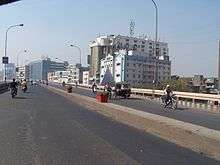
Since it is known for producing textiles, including silk, Surat is known as the textile hub of the nation or the Silk City of India. It is very famous for its cotton mills and Surat Zari Craft. Surat is the biggest centre of MMF (man-made fibre) in India. It has a total of 381 dyeing and printing mills and 41,100 power loom units. There are over a hundred thousand units and mills in total. The overall annual turnover is around 5 billion rupees. There are over 800 cloth wholesalers in Surat.[37] It is the largest manufacturer of clothes in India, and Surti dress material can be found in any state of India. Surat produces 9 million metres of fabric annually, which accounts for 60% of the total polyester cloth production in India. Now the city is focusing on increasing the exports of its textile.[38]
Information technology
There are many SME Domestic IT Companies present in Surat. MNC IT companies like IBM,[39] HCL have satellite or virtual branches in Surat. On 14 February 2014, Government of Gujarat DST had handover STPI Surat[40][41] at Bhestan-Jiav Road, Bhestan Near Udhana-Sachin BRTS Route.
Surat city administration will demand for setting up of an information technology (IT) hub and an Indian Institute of Information Technology (IIIT) on the outskirts of the city.[42]
Microsoft CityNext initiative has tied up with IT services majors Tata Consultancy Services and Wipro to leverage technology for sustainable growth of cities in India. The first smart IT city in India is being constituted by the Microsoft CityNext Initiative in Surat, Gujarat.[14] In 2011, Surat hosted India's first Microsoft DreamSpark Yatra (a tech event) with speakers from Microsoft Headquarters at Redmond, Washington. The event was organised by Ex-Microsoft Student Partner Samarth Zankharia.[43]
In May 2015, Tech giant IBM has chosen Surat among 16 global locations for its smart cities program to help them address challenges like waste management, disaster management and citizen services. Under the program, IBM will send a team of experts to each of the chosen cities where they will spend three weeks working closely with city staff analysing data about critical issues faced by its local bodies;[44][17] the co-operation continued into 2016.[16]
Diamond Research And Mercantile City (DREAM)

The government of Gujarat plans another project near Surat similar to Gujarat International Finance Tec-City (GIFT). The Chief Minister has suggested that the government wishes to develop DREAM to have a five-seven star hotel, bank, IT, corporate trading house, entertainment zone and other facilities while the Surat Diamond Bourse (SBD) will be based there. Allotment of Khajod land for the project is convenient for the state government because they have 2,000 acres (810 ha) of available land. The Trade Centre, located near Sarsana village, will have a 100,160-square-metre (1,078,100 sq ft) pillar-less air-conditioned hall with a 90-by-35-metre (295 by 115 ft) pillar-less dome.[45][46]
Transport
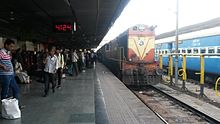
Built in 1860, Surat railway station falls under the administrative control of Western Railway zone of the Indian Railways. In early 2016, the Indian Railway Catering and Tourism Corporation rated the facility the best large station in India based on cleanliness.
The Sitilink or Surat BRTS is a bus rapid transit system in the city. Initiated by Bharat Shah, additional city engineer of Surat Municipal Corporation. It is operated by Surat Municipal Corporation and as of August 2017, had a network of 245 buses connecting major localities.[47]
Surat International Airport located in Magdalla, 11 kilometres (7 mi) southwest of Surat. It is the 2nd busiest airport in Gujarat in terms of both aircraft movements and passenger traffic. Currently, airlines such as Air India, Alliance Air, AirAsia India, SpiceJet, IndiGo Airlines, Air Odisha, Ventura AirConnect provide flight services from the Surat to various major cities like New Delhi, Mumbai, Kolkata, Chennai, Bengaluru, Hyderabad, Goa, Jaipur, Visakhapatnam. There are also running international flights for the Sharjah route of Air India Express. Apart from the main city, Surat Airport also caters to various localities of south Gujarat including Navsari, Bardoli, Valsad, Bharuch, Ankleshwar.
Surat Metro is a proposed rapid transit rail system for the city.[48]
Civic institutions

The Surat Municipal Corporation is responsible for maintaining city's civic infrastructure as well as carrying out associated administrative duties. At present, BJP is the ruling party with a majority. Under the Provisions of Bombay Provincial Municipal Corporations Act, 1949, Section – 4, the powers have been vested in three Distinct Statutory Authorities: the General Board, the Standing Committee, and the Municipal Commissioner. It ranked 7 out of 21 cities for best administrative practices in India in 2014. It scored 3.5 on 10 compared to the national average of 3.3. It is the only city in India to disclose municipal budgets on a weekly basis.[49]
Science centre
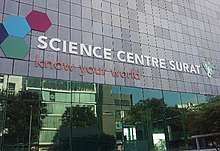
Science Centre, Surat is a multi-facility complex built by the Surat Municipal Corporation in 2009, the first of its type in western India. The complex houses a science centre, museum, an art gallery, an auditorium, an amphitheatre, and a planetarium.
Pandit Dindayal Upadhyay Indoor Stadium

With a seating capacity of 6800, Pandit Dindayal Upadhyay Indoor Stadium is the first of its kind in the Western Region of India. The stadium frequently organises national and international indoor games such as volleyball, table tennis, gymnastics, handball, boxing, wrestling, badminton, basketball, and tennis. It has a central arena of size 63 m x 33 m, rooms for participants and team officials, and other essential facilities including snack bars. This is also a convenient venue for organizing cultural programs, music concerts, drama, fashion shows, seminars, conferences and many more. The Indoor Stadium also hosted TEDxSurat 2018 on 7 October 2018 which is the largest TEDx conference of Gujarat and one of the largest TEDx conference of the world.[50]
Lalbhai Contractor Cricket Stadium
Lalbhai contractor cricket stadium has a capacity of more than 7000 and hosted several Ranji, Irani and Duleep Trophy matches. The stadium also serves as a primary destination for local budding cricketers and enthusiasts. The stadium has hosted several benefit matches for international cricketers as well.
Public Safety
Surat began the 'Safe City Project' in 2011 aimed at keeping the city safe using surveillance cameras. The project was headed by Sanjay Srivastava (IPS) who was then the Joint-Commissioner of Surat Police. The 280-square-foot video wall, claimed to be the largest surveillance screen in the country, is being installed at the control room of Police Commissioner Mr. Rakesh Asthana (IPS). This will help the police view the entire city live through 10,000 CCTV cameras across the city. Surat police have decided to install 5,000 CCTV cameras at sensitive points across the city. While 1,000 cameras will be night vision cameras, 4,000 others will be simple CCTV cameras. This has been installed on PPP base with the help of the city's businessmen, city's social persons, Surat Municipal Corporation and Surat City Police. [51]
Demographics
| Population Growth of Surat | |||
|---|---|---|---|
| Census | Population | %± | |
| 1871 | 107,100 | — | |
| 1881 | 109,800 | 2.5% | |
| 1891 | 109,200 | −0.5% | |
| 1901 | 119,300 | 9.2% | |
| 1911 | 114,900 | −3.7% | |
| 1921 | 117,400 | 2.2% | |
| 1931 | 98,900 | −15.8% | |
| 1941 | 171,400 | 73.3% | |
| 1951 | 223,200 | 30.2% | |
| 1961 | 288,000 | 29.0% | |
| 1971 | 492,700 | 71.1% | |
| 1981 | 912,600 | 85.2% | |
| 1991 | 1,519,000 | 66.4% | |
| 2001 | 2,811,614 | 85.1% | |
| 2011 | 4,591,246 | 63.3% | |
| source:[53] | |||
According to the 2011 India census, the population of Surat is 4,462,002. Surat has an average literacy rate of 89%, higher than the national average of 79.5%, male literacy is 93%, and female literacy is 84%.[52]
Males constitute 53% of the population and females 47%. In Surat, 13% of the population is under 6 years of age.
Education
Universities
Sardar Vallabhbhai National Institute of Technology, Surat is one of 31 National Institutes of Technology that are recognised as Institutes of National Importance by the Government of India. Indian Institute of Information Technology, Surat started in 2017.[54]
Most of the regional colleges are affiliated to Veer Narmad South Gujarat University (VNSGU, named after the poet Veer Narmad), which has headquarters in the Surat Metropolitan Region. Colleges are also affiliated to SNDT , Gujarat Technological University and other universities. Government Medical College, Surat is a more than 50 years old medical school of 250 yearly student admission capacity with attached tertiary care hospital, New Civil Hospital. Surat Municipal Institute of Medical Education and Research (SMIMER) is a Municipal Medical College affiliated with the Veer Narmad South Gujarat University. Auro University has also started to provide education in Surat.[55]
Culture
Food
Surat is famous for its food all over India. There is a famous saying in Gujarati language "સુરતનું જમણ અને કાશીનું મરણ", meaning Eat in Surat and Die in Kashi for the ultimate experience of the soul.[56][57][58][59][60][61]

The unique dishes of surat includes Locho, Ghari (sweet), Ponk, Undhiyu, Khaman, Sev Khamani etc.
Surat in Literature
- The Coffee-House of Surrat [62] - By Leo Tolstoy
- A Voyage to Surat in the Year 1689[63] - by John Ovington
- Gazetteer of the Bombay Presidency: Gujarát Surat and Broach [64]
- The Land of Malabar [65] - by Duarte Barbosa
People
- Henry Barnes-Lawrence (1815–1896), Anglican clergyman, and founder of the Association for the Protection of Sea-Birds[66]
- Kiransinh Chauhan, Gujarati poet and scriptwriter
- Ismail Darbar, Bollywood composer[67]
- Freddy Daruwala, Bollywood Actor
- Hashim Amla, South African Cricketer
- Harmeet Desai, table-tennis player
- Prachi Desai, actress in Bollywood[68]
- Savji Dholakia, Indian businessman. He is the founder and chairman of Hari Krishna Export.
- Sanjeev Kumar (actual name Haribhai Jariwala), film actor[69]
- Mareez, 20th century Gujarati poet, popular for his ghazals
- Narmad, Gujarati poet, playwright, essayist, orator, lexicographer and reformer under the British Raj
- Dhwanil Parekh, 20th century Gujarati poet
- Hardik Pandya, Indian international Cricketer
- Laljibhai Patel, an Indian diamantaire and philanthropic social activist, who is the chairman of Dharmanandan Diamonds Pvt. Ltd.(DDPL)
- Hendrik van Rheede (1636–1691), Dutch botanist and colonial administrator. Died of the coast of Mumbai and was buried at the Dutch Cemetery in Surat.
- Mufaddal Saifuddin religious leader of the Dawoodi Bohra
- Gunvant Shah, educationist and columnist
- Bhagwatikumar Sharma, author and journalist
- Farooq Sheikh, actor and television presenter[70]
- Virji Vora, businessman known as "merchant prince" during Mughal era[71]
See also
- List of tourist attractions in Surat
- Surat Railway Station
- Surat International Airport
- Surat BRTS
- Surat Metro
- Surat Metropolitan Region
References
- "Surat: India's 'Diamond City' finds ways to keep its sparkle". Archived from the original on 2 August 2018. Retrieved 1 August 2018.
- "Ashmita Shiroya is Surat's New Mayor". tv9gujarati. 12 February 2016. Archived from the original on 25 December 2015. Retrieved 15 December 2015.
- "પોલીસ કમિશનરશ્રીની કચેરી, સુરત". Archived from the original on 5 March 2016. Retrieved 10 February 2016.
- "Statistics for Surat Municipal Corporation". Official website of Surat Municipal Corporation. Archived from the original on 15 September 2015. Retrieved 4 June 2015.
- "District Census Handbook – Surat" (PDF). Census of India. p. 40. Archived (PDF) from the original on 13 November 2015. Retrieved 10 February 2016.
- "World urban areas" (PDF). Archived (PDF) from the original on 5 August 2011. Retrieved 21 April 2019.
- "SURAT GETS ADDL GJ-5 & GJ-28 SERIES FOR VEHICLE REGISTRATION". dnaindia.com. Archived from the original on 14 May 2016. Retrieved 12 February 2016.
- "Distribution of Population, Decadal Growth Rate, Sex-Ratio and Population Density". 2011 census of India. Government of India. Archived from the original on 13 November 2011. Retrieved 12 February 2016.
- "Literacy Rates by Sext for State and District". 2011 census of India. Government of India. Archived from the original on 13 November 2011. Retrieved 25 June 2012.
- "History of Surat". Archived from the original on 5 January 2012.
- "Fastest growing city in world". www.citymayors.com. Archived from the original on 25 November 2010. Retrieved 6 February 2016.
- Agencies. "GDP growth: Surat fastest, Mumbai largest". The Financial Express. Archived from the original on 24 September 2014. Retrieved 27 July 2015.
- "Best City in India". The Times of India. Archived from the original on 17 June 2013. Retrieved 17 February 2014.
- "Microsoft CityNext initiative set to the launch First smart IT city in India". Archived from the original on 17 October 2015. Retrieved 27 July 2015.
- "Mumbai has highest number of Internet users in India: Study". 4 November 2014. Archived from the original on 15 June 2016. Retrieved 4 November 2014.
- "City of Surat to Improve Citizen Services with IBM Smarter Cities Program – India". IBM News room. 12 February 2016. Archived from the original on 2 February 2017. Retrieved 21 January 2017.
- "Surat, India 2015 challenge". IBM Smarter Cities. IBM. Archived from the original on 2 February 2017. Retrieved 21 January 2017.
- "Government releases list of 20 smart cities – Times of India". The Times of India. Archived from the original on 2 February 2016. Retrieved 6 February 2016.
- "Full list of Swachh Survekshan 2017 Rankings: Know where your city ranks in Swachh Bharat survey". The Financial Express. 4 May 2017. Archived from the original on 3 January 2019. Retrieved 2 January 2019.
- "Surat". Encyclopædia Britannica. Encyclopædia Britannica, inc. 6 August 2014. Archived from the original on 10 January 2018. Retrieved 9 January 2018.
- http://el.travelogues.gr/collection.php?view=375
- http://www.columbia.edu/itc/mealac/pritchett/00routesdata/1700_1799/malabar/surat/surat.html
- Abraham Eraly (2007). The Mughal World: Life in India's Last Golden Age. Penguin Books India. pp. 13–14. ISBN 978-0143102625.
- Ghulam A. Nadri (2009). Eighteenth-Century Gujarat: The Dynamics of Its Political Economy, 1750–1800. p. 193. ISBN 978-9004172029. Archived from the original on 14 October 2017. Retrieved 14 October 2017.
- "Location". latlong.
- "Performance of buildings during the 2001 Bhuj earthquake" (PDF). Jag Mohan Humar, David Lau, and Jean-Robert Pierre. The Canadian Association for Earthquake Engineering. Archived from the original (PDF) on 10 July 2007. Retrieved 3 August 2008.
- "What Surat learned from a preventable flood | Citiscope". citiscope.org. Archived from the original on 8 March 2018. Retrieved 8 March 2018.
- "State fails to find solution to Surat floods – Times of India". The Times of India. Archived from the original on 8 March 2018. Retrieved 8 March 2018.
- "Station: Surat Climatological Table 1981–2010" (PDF). Climatological Normals 1981–2010. India Meteorological Department. January 2015. pp. 729–730. Archived from the original (PDF) on 5 February 2020. Retrieved 19 March 2020.
- "Extremes of Temperature & Rainfall for Indian Stations (Up to 2012)" (PDF). India Meteorological Department. December 2016. p. M260. Archived from the original (PDF) on 5 February 2020. Retrieved 19 March 2020.
- "Surat Climatological Table Period: 1981–2010". India Meteorological Department. Archived from the original on 2 April 2015. Retrieved 25 March 2015.
- "The 150 richest cities in the world by GDP in 2020". Archived from the original on 9 February 2014. Retrieved 24 February 2014.
- "Indian diamond cutting and polishing sector". Rough&Polished. 6 March 2013. Archived from the original on 3 February 2015. Retrieved 3 February 2015.
- "Diamond and Patels". 1999. CiteSeerX 10.1.1.1026.5615. Cite journal requires
|journal=(help) - India's Diamond Polishers Facing Massive Job Losses, The Times of India
- "gujarattourism". www.gujarattourism.com. Archived from the original on 13 November 2018. Retrieved 13 November 2018.
- "Industries Information". Collectorate Surat District, Government of India. Archived from the original on 2 May 2014. Retrieved 1 May 2014.
- Thomas, Melvyn R. (15 February 2015). "Surat's textile exporters eyeing US market". The Times of India. Archived from the original on 24 March 2014. Retrieved 1 May 2014.
- BS Reporter (7 July 2010). "IBM opens virtual branch office in Surat". Business Standard India. Retrieved 27 July 2015.
- Archived 20 March 2014 at the Wayback Machine
- Archived 9 March 2014 at the Wayback Machine
- "SMC to seek setting up of IT hub and IIT". The Times of India. Archived from the original on 17 October 2015. Retrieved 27 July 2015.
- "Microsoft Kick Starts DreamSpark Yatra 2011". Microsoft India. Microsoft. 27 January 2011. Archived from the original on 18 April 2012. Retrieved 27 July 2015.
- "IBM picks Surat, Allahabad & Vizag among 16 global locations for smart cities project". The Economic Times. Archived from the original on 15 May 2015. Retrieved 27 July 2015.
- "Althan, Khajod next in line for mega development". The Times of India. Archived from the original on 17 October 2015. Retrieved 27 July 2015.
- "Gujarat govt plans GIFT city like project close to Surat". DeshGujarat. 31 August 2014. Archived from the original on 29 July 2015. Retrieved 27 July 2015.
- "SMC takes over city bus, BRTS services from private operator – Times of India". The Times of India. Archived from the original on 15 March 2018. Retrieved 14 March 2018.
- "Narendra Modi announces state's approval to Surat Metro train project". DeshGujarat.com. 11 August 2012. Archived from the original on 3 March 2013. Retrieved 1 January 2013.
- Gumber, Anurag (6 June 2014). Annual Survey of India's City-Systems (PDF) (2nd ed.). Bangalore: Janaagraha Centre for Citizenship and Democracy. pp. 64–68. Archived (PDF) from the original on 19 March 2015. Retrieved 5 March 2015.
- "Surat Municipal Corporation". Archived from the original on 11 March 2018.
- Business Standard (19 January 2013). "Surat to have new security system". Business Standard India. Business Standard. Retrieved 3 February 2013.
- "Surat City Population Census 2011 – Gujarat". Archived from the original on 29 June 2015. Retrieved 27 July 2015.
- "Historical Census of India". Archived from the original on 17 February 2013. Retrieved 23 March 2014.
- "IIIT research centre soon in Surat". Archived from the original on 29 July 2018. Retrieved 1 August 2018.
- "AURO University – MBA, BBA, Hospitality Management Degree Programs, BBA+LLB, BSc IT Courses in Surat Gujarat India". Aurouniversity.edu.in. Archived from the original on 27 January 2013. Retrieved 3 February 2013.
- Tripathi, Vaishali (2016). Indian desi tadka. Onlinegatha. p. 105. ISBN 9789385818004.
- Iyer, Raghavan (2016). 660 Curries. Workman Publishing. p. 539. ISBN 9780761187462.
- Mar 6, Melvyn Thomas | TNN |; 2013; Ist, 17:28. "There is an old saying 'Surat Nu Jaman Ane Kashi Nu Maran' which means Eat in Surat and Die in Kashi for the ultimate experience of the soul. But, fate of around 200 fine dining restaurants in the diamond city hangs in balance as all the a/c restaurants have come under the service tax net. - Times of India". The Times of India. Retrieved 11 June 2020.CS1 maint: numeric names: authors list (link)
- "સુરતની ઘારી માટે એમ કહી શકાય કે, 'યે અંગ્રેજો કે જમાને કી મીઠાઈ હૈ...!!!'". Zee News Gujarati. 11 October 2019. Retrieved 11 June 2020.
- Gulal - TB. New Saraswati House India Pvt Ltd. p. 47. ISBN 9789351991441.
- Feb 2, Updated:; 2013; Ist, 19:19. "Gujju goes global". Bangalore Mirror. Retrieved 11 June 2020.CS1 maint: extra punctuation (link) CS1 maint: numeric names: authors list (link)
- "The Coffee House of Surat". www.goodreads.com. Retrieved 11 April 2020.
- =OVPc5Z6y3LkC&lpg=PP1&dq=surat&pg=PP1#v=onepage&q=surat&f=false
- "Gazetteer of the Bombay Presidency: Gujarát Surat and Broach". 1877.
- https://www.worldcat.org/title/land-of-malabar-the-book-of-duarte-barbosa-vol-ii/oclc/53921669
- "Hansard: Sea Birds Preservation Bill, Lord's Committee". Archived from the original on 12 March 2017. Retrieved 1 January 2018.
- Nayak, Elina Priyadarshini (2 July 2011). "Ismail Darbar wants to serve the people of Surat – Times of India". The Times of India. Times News Network. Archived from the original on 10 October 2017. Retrieved 9 October 2017.
- Ghai, Rajat (9 December 2007). "I am lucky:Prachi Desai – Times of India". The Times of India. Archived from the original on 13 January 2018. Retrieved 8 October 2017.
- Dhawan, M.L. (13 August 2000). "He was an actor for all seasons". The Tribune. Archived from the original on 3 March 2018. Retrieved 26 September 2017.
- "Farooq Shaikh – Movies, Biography, News, Age & Photos". BookMyShow. Archived from the original on 9 October 2017. Retrieved 9 October 2017.
- Archives, The National. "The Discovery Service". discovery.nationalarchives.gov.uk. Archived from the original on 28 February 2018. Retrieved 27 February 2018.
External links
| Wikimedia Commons has media related to Surat. |
| Wikivoyage has a travel guide for Surat. |
- Website of Surat Municipal Corporation

- . New International Encyclopedia. 1905.

